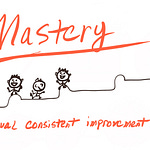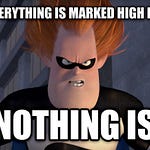It’s fascinating to learn about the history of “EdTech.” In broad strokes, based on what I’ve learned so far, the consensus seems to be that Salman Khan was the pioneer who really kicked things off for an entirely new industry. By 2012, Coursera, EdX, and Udacity were major players in the space. As things continued to coalesce and evolve since then, technology (a.k.a. “tech”) has only gotten better, as have the processes for developing that technology. However, despite massive strides being taken toward democratizing education, things have hardly gone as planned. For example, the idea that the world would only have 10 universities sooner than later, and that Udacity might be one of them, didn’t exactly pan out.
Meanwhile, Product Management has co-evolved as a discipline. One way to mark the formalization of the role is with Ken Norton’s classic essay How to Hire a Product Manager, which perhaps more aptly might have been called “What is a Product Manager?”
As a result, practitioners at the intersection of both product management and education - folks in my realm - know that we have a bit of a chicken-and-egg problem when it comes to “Ed” and “Tech.” Namely, which comes first, the ed or the tech? The order of operations here is so critical to understand because to tackle “What is an ed-tech product manager?” you have to first begin by clarifying what kind of “EdTech product” is being built.
If it’s a product that leads with tech, the person responsible for building it probably holds the title of product manager. Classic.
On the other hand, if we’re talking about a product that leads with ed, the person responsible for bringing the offering to market probably holds the title of - well, once again - product manager. Less often, you might find roles like Curriculum Product Manager or Curriculum Lead (or Product Lead, Curriculum). Or on and on, exacerbating the confusion.
Taking things even a step further, new business models have emerged where the platform (i.e., the product) is provided as a sort of education container to connect instructors with star power and expertise to paying customers. Companies like Maven, CoRise, and Sphere provide the tech and let the educators bring the ed.
Other models are based more on the power of community than anything else. On Deck, Building a Second Brain (BASB), and Ship 30 for 30 were all early players in the EdTech game when COVID hit, saw massive early success, and have since evolved their approaches and business models to continue growing over time. In the case of BASB and Ship 30 for 30, as the communities have grown the founders have significantly grown their own personal brands and star power.
There are further differentiators to consider as well. For example, who is the learner? Who is the customer? B2C and B2B businesses have both seen success and failure, but the overall trend in the industry is certainly toward B2B (and ARR, MRR, and subscription-based pricing in general).
I’ve spent the last year and a half at FourthBrain, working alongside companies like Deeplearning.ai, observing the evolution of other EdTech companies within the AI Fund like Workera, Kira Learning, and Filtered, and interviewing EdTech/Product/Curriculum/Content practitioners who are alumni of companies like Udacity, 2U, Chegg, Pathstream, General Assembly, and others. Many of the instructors on our staff have previously taught boot camp-style courses as well like those at Galvanize and Lambda School.
Within that context, this blog post is kind of my own personal investigation into thinking about what exactly the future of education might look like. What should it look like? With money finally becoming expensive again, what is the next stage of this evolution?
To best predict the future, it's important to study the past. So, without further ado, it’s instructive to introduce a distinction between three common departments that you’ll find within established EdTech companies: product, curriculum, and content.
Product, Curriculum, and Content
To develop a proper baseline for a differentiated analysis in 2023, we would be remiss if we didn’t kick things off by sticking our key question to ChatGPT.
Let’s do that now:
What is the difference between product, curriculum, and content in EdTech startups?
Product refers to the overall offering of an EdTech startup, which typically includes technology, software, or hardware that is designed to support education and learning.
Curriculum refers to the specific course or set of courses that the EdTech startup offers, which is usually aligned with educational standards and designed to meet specific learning outcomes.
Content refers to the material or information that is presented in the courses, such as video lessons, interactive activities, and assessments. The content is typically created by subject matter experts and is intended to engage students and help them learn.
In summary, the product is the overall solution offered by the EdTech startup, the curriculum is the structure of the courses that the product offers, and the content is the material that is taught within the courses
Well-played ChatGPT.
I like this answer a lot, especially the summary that seems to make this crisp and hierarchical (that is, product —> curriculum —> content). But it doesn’t tell the whole story.
To introduce the topic as a human, let’s consider two brief vignettes:
When I started at FourthBrain, I was insistent on the fact that my title was to be “Head of Product” despite the fact that the former person holding my role had the title “Director of Curriculum.” This was very important to me, as I identified (and still identify) a “product person.”
During an interview with a “Head of Content” who had worked within big EdTech for years, when I asked them if they considered themselves a “product person” they responded with mild disgust that “no,” they weren’t. However, they recommended Marty Cagan’s Inspired book as one that I should read and told me “I’m not saying that I’m a PM. I have good user empathy; I have good product sense.” … hmm🤔.
In big EdTech, product, curriculum, and content are generally three separate departments. The word on the street is that product makes the decisions (even though they know little to nothing about education in many cases), Curriculum then creates the educational content that Product decides they need, and Content generally belongs to Marketing (e.g., think “content marketing”). One thing that I heard over and over again, is that during a downturn, Curriculum employees are the first to be dispensed with. Education is simply not the game that pays. No surprises there!
However, in startups like the bootcamp-style one that we’ve been building at FourthBrain, product, curriculum, and content are centralized around the core “product” (often actually a service) that is being offered to customers (students). In essence, all three of these departments are centralized within a lean executive team. In other words, they are all part of the same learning transformation that we hope to put our students through. That’s where the value is created.
As an aside, It’s worth noting here that many product/content/curriculum practitioners in EdTech today consider themselves students of teaching and learning, and you’ll often find the word “learning” either in their current title or university degree.
Another interesting tidbit here is that over the past few quarters, as my role has evolved I’ve become more comfortable with each of these component pieces. For a time, I went by Head of Product, before adapting the title to be more descriptive as Head of Product & Curriculum. Now, I consider myself Head of Product, Content Strategy, and Curriculum.
So how did I get here?
Let’s dive in, and hopefully derive some insights about the brave new educational and technological future out there for all of us in the 21st century!
Centralized vs. Decentralized EdTech Approaches
When everything is centralized across a lean executive team in a startup, it’s much easier to do cross-functional things. For example, I have purview and influence over high-level product strategy, core curriculum, as well as the way we market our products to the world. It’s easy for us to pivot and make decisions quickly, then ship what needs to be shipped.
However, the downside of a lean team within this kind of early-stage startup is that it quickly becomes overwhelming with the amount of time that it takes to really do multiple jobs across functions. At times, it is very difficult to figure out how to best prioritize and execute.
On the other hand, a larger organization that has separate departments limits the scope and scale of influence for its departmental Directors. This is both a gift and a curse because decisions often get caught up in bureaucracy, at least for a time. This has the potential to decrease the total value that may have been realized in a more agile environment. Think about those companies that have shipped ChatGPT courses in just the past few months, versus those that haven’t. At the same time, it’s easier to determine what levers of control you own, and which are owned by your counterpart(s) across the company. There is certainly something to be said for clarity over ambiguity here.
At some point throughout the growth of any company, small becomes large, and departments (whether functional or by product/division) are created.
In other words, centralized and decentralized approaches inevitably must be balanced at each step to maximize the probability that the company will achieve its current goals.
Defining an EdTech Product Manager
So here we have a few distinctions that we’ve collected so far:
Product vs. Curriculum vs. Content: these are the core components that make up revenue-generating learning transformations
Centralized vs. Decentralized: think of a lean startup versus a larger organization with functional or divisional departments.
If the future of education is truly community, and cohort-based courses (CBCs) are the flagship “product” that demonstrate this transition, then we need to bring one other key idea into focus: Community.
I personally believe that community is the key competitive advantage of universities today. Without community, they would not be able to compete. Replicating the power of community in a fully remote online environment seems to be the golden goose that everyone is chasing.
Think about the friends that you made when you started going to college who are still your friends today.
Creating relationships like this is an absolute necessity to get the future of education right.
Outcomes like these are the ones that truly propel individuals forward in the world.
Product, Curriculum, Content, and Community
Where does this leave us then?
Quite simply, it appears to me that to be the most effective EdTech product manager, you need to be a student of digital product management, of structuring curriculum (in your particular domain of practice), of creating and leveraging content (for both internal customers and potentially new external customers), and of building community.

What is the ed-tech product lifecycle that you need to consider? It starts with the top of the funnel and how students find you. It includes what prerequisites students need to succeed coming in. It also includes not only the core curriculum and content but also how it’s delivered. How are you providing 1-1 coaching feedback and guiding students, ensuring that they feel supported, heard, and understood? What are you doing to foster community collaboration throughout the service you provide, including after the course is taught? What does it mean to be an alum of your product?
Importantly, what are you doing to foster relationships among learners, during and after the program? Are they meeting others that will continue along similar paths? When is their transformation complete? Is it ever going to be fully complete? How does this affect the company’s business model and ARR?
If you’re not there yet in terms of quality ratings, or in terms of your ability to serve the entire product lifecycle so that you generate revenue and at the same time bring about the best possible outcomes for students, what are you doing during your current cohorts and on your current product/curriculum/content teams to run your operations in an agile way that collects both anecdotal and structured data which will allow you to best improve over time?
After all, anyone who’s ever taught a class knows that the first time through is always the absolute worst. So in the end, the product is not all that different than education, because if you’re not shipping something that you’re embarrassed by, then you’re shipping too late.
I can’t wait to see what sorts of learning products, curricula, content, and communities are built and shipped in 2023 and beyond.
Whatever they are, I look forward to being a part of the online #teachingandlearning movement as the education revolution continues to unfold.










